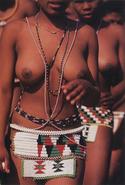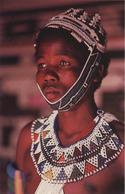
Histories of Change
Dress and Adornment of Rural South Africa
New Traditions
It is usually assumed that all rural traditions date back to pre-colonial times, but the practice of inventing new ones is fairly common both in South Africa and elsewhere. In the mid-1980s Zulu King Goodwill Zwelithini introduced a Reed Ceremony similar to that held annually in Swaziland, the previous home of his first wife.
While the primary purpose of the annual Reed ceremony is to celebrate the fertility of young women, it also affords an opportunity to encourage them to refrain from indulging in premarital sexual relations. The preceding official virginity testing ceremony is valued by some participants, but condemned by others.
The beadwork worn on these occasions attests to regional variations in style. These differences are reflected in the use of bead colours and patterns.
Past and Present
Throughout South Africa, some beadwork styles still rely on small glass beads, but others use larger plastic beads that have recently become readily available. These locally manufactured plastic beads are comparatively inexpensive. Some items combine small and large beads in innovative ways.
In many cases, initiates wear both newly made beadwork pieces and heirloom items that have been passed down from one generation to the next. Initiates generally take great pride in wearing beaded garments that once belonged to other members of their families.
In the past, Ndebele women wore brass leg rings in combination with bulbous beaded ones. The brass rings were attached permanently to the legs, arms and necks of newly married women.
The brass-coloured rings Ndebele women wear today are commonly made from plastic. These rings can be clipped off when women resume their day-to-day activities following ceremonial occasions that also require them to dress in elaborately beaded capes.
Changing Attitudes to Transforming the Body
A few married Ndebele women still have brass rings permanently attached to their necks. Over time, neck rings like these stretched their vertebrae and distorted the shape of their collarbones, leading to permanent deformations.
Partly because most women no longer wear older forms of dress on a daily basis, neck rings now have clasps, thereby allowing women to reserve them for special occasions like weddings.
By
Professor Sandra Klopper
















